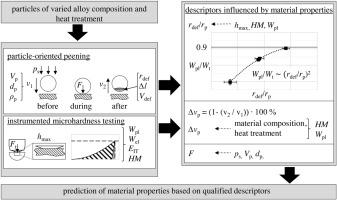当前位置:
X-MOL 学术
›
J. Mater. Process. Tech.
›
论文详情
Our official English website, www.x-mol.net, welcomes your
feedback! (Note: you will need to create a separate account there.)
Particle-oriented peening as method to investigate the material dependent deformation behaviour
Journal of Materials Processing Technology ( IF 6.7 ) Pub Date : 2021-03-01 , DOI: 10.1016/j.jmatprotec.2020.116960 Nicole Wielki , Heike Sonnenberg , Daniel Meyer , Brigitte Clausen
Journal of Materials Processing Technology ( IF 6.7 ) Pub Date : 2021-03-01 , DOI: 10.1016/j.jmatprotec.2020.116960 Nicole Wielki , Heike Sonnenberg , Daniel Meyer , Brigitte Clausen

|
Abstract The material and its microstructure define the behaviour of a part in a deformation process. A single particle deformation process is introduced as a rapid material characterization method extending already existing approaches. Particle-oriented peening is performed with spherical micro samples of the low carbon steel 100Cr6 (AISI 52100) and the martensitic stainless steel X46Cr13 (AISI 420). Three different diameters (0.6 mm, 0.8 mm and 1.0 mm) were chosen to investigate the impact of the material and the surface to volume ratio. By processing single particles, the mechanical and geometrical properties of the particle before and after the impact can be linked to the deformation behaviour during the peening process. The elastic and plastic material properties are revealed by studying the remaining plastic deformation of the particle and the velocity reduction as a result of the impact. Instrumented universal micro hardness measurements are carried out to determine the hardness of the particles and to correlate it with the behavior of the particles during the particle-oriented peening process. The plastic deformation work as a characteristic value of micro hardness measurements of the different material states is discussed. It is conceivable that the consideration of different material behaviour related values (so-called descriptors) may replace conventional material testing in the future. Using short-term characterization methods like the particle-oriented peening a fast determination of material properties is possible.
中文翻译:

粒子定向喷丸作为研究材料相关变形行为的方法
摘要 材料及其微观结构定义了零件在变形过程中的行为。引入单粒子变形过程作为扩展现有方法的快速材料表征方法。对低碳钢 100Cr6 (AISI 52100) 和马氏体不锈钢 X46Cr13 (AISI 420) 的球形微观样品进行颗粒取向喷丸。选择了三种不同的直径(0.6 毫米、0.8 毫米和 1.0 毫米)来研究材料和表面体积比的影响。通过处理单个颗粒,可以将撞击前后颗粒的机械和几何特性与喷丸过程中的变形行为联系起来。通过研究粒子的剩余塑性变形和冲击导致的速度降低,可以揭示弹性和塑性材料特性。进行仪器化的通用显微硬度测量,以确定颗粒的硬度,并将其与颗粒定向喷丸过程中颗粒的行为相关联。讨论了作为不同材料状态显微硬度测量特征值的塑性变形功。可以想象,对不同材料行为相关值(所谓的描述符)的考虑可能会在未来取代传统的材料测试。使用短期表征方法(如面向颗粒的喷丸)可以快速确定材料特性。
更新日期:2021-03-01
中文翻译:

粒子定向喷丸作为研究材料相关变形行为的方法
摘要 材料及其微观结构定义了零件在变形过程中的行为。引入单粒子变形过程作为扩展现有方法的快速材料表征方法。对低碳钢 100Cr6 (AISI 52100) 和马氏体不锈钢 X46Cr13 (AISI 420) 的球形微观样品进行颗粒取向喷丸。选择了三种不同的直径(0.6 毫米、0.8 毫米和 1.0 毫米)来研究材料和表面体积比的影响。通过处理单个颗粒,可以将撞击前后颗粒的机械和几何特性与喷丸过程中的变形行为联系起来。通过研究粒子的剩余塑性变形和冲击导致的速度降低,可以揭示弹性和塑性材料特性。进行仪器化的通用显微硬度测量,以确定颗粒的硬度,并将其与颗粒定向喷丸过程中颗粒的行为相关联。讨论了作为不同材料状态显微硬度测量特征值的塑性变形功。可以想象,对不同材料行为相关值(所谓的描述符)的考虑可能会在未来取代传统的材料测试。使用短期表征方法(如面向颗粒的喷丸)可以快速确定材料特性。











































 京公网安备 11010802027423号
京公网安备 11010802027423号